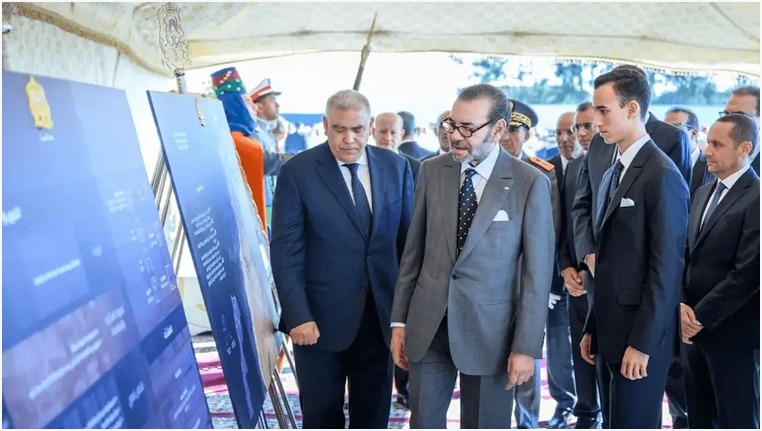His Majesty King Mohammed VI accompanied by His Royal Highness Crown Prince Moulay El Hassan, launched on Wednesday in the commune of Ameur (Salé prefecture), the construction of the Rabat-Salé-Kenitra region’s essential reserves platform, an embodiment of the Moroccan model of resilience and swift deployment of disaster relief.
By Order of His Majesty the King, each region of the Kingdom will be provided with a large platform of essential reserves (tents, blankets, beds, medicines, foodstuffs, etc.) in order to respond immediately to disasters (floods, earthquakes, chemical, industrial or radiological hazards).
The Rabat-Salé-Kenitra region’s essential reserves platform will be built on a 20-hectare site within 12 months, with a total estimated budget of MAD 287.5 million. The project will mainly include the construction of four warehouses (5,000 m² each), two shelters for oversized equipment (2,500 m² each), a helipad and parking lots.
This regional platform is part of a comprehensive program, presented to His Majesty the King on this occasion, which plans for the construction of twelve platforms at a total cost of around MAD 7 billion, including MAD 2 billion for construction and MAD 5 billion for the purchase of products and equipment.
Mobilizing an estimated total land area of 240 ha, these platforms will house 36 warehouses, distributed according to each region’s population density and its respective risks.
For the six regions of Casablanca-Settat, Rabat-Salé-Kenitra, Marrakech-Safi, Fez-Meknes, Tanger-Tetouan-Al Hoceima and Souss-Massa, the platforms will comprise four warehouses, each with a total surface area of 20,000 m². Platforms in the other six regions — Eastern region, Beni Mellal-Khenifra, Draa-Tafilalet, Guelmim-Oued Noun, Laayoune-Sakia El Hamra and Dakhla-Oued Ed Dahab — will include two warehouses, each with a total surface area of 10,000 m².
The products and equipment to be stored in these areas aim to ensure, in the event of a disaster, a swift response to aid affected populations, as well as a prompt and reasonable coverage of needs in terms of rescue, aid and care, in line with His Majesty the King’s proactive Vision.
On this basis, these products and equipment, intended for immediate deployment following the possible occurrence of a natural disaster, cover the following main categories:
– Shelter, with the provision of 200,000 multi-purpose tents and associated equipment (cots, mattresses, blankets …);
– Catering for disaster victims with mobile bakeries and kitchens, as well as food kits to meet the needs of affected families;
– Covering the drinking water and electricity needs of disaster victims by providing water purification and potabilization equipment, as well as electrical power generation using towable generators;
– Developing rescue and response capacities in the occurrence of disaster. This mainly involves building up stocks of flood control equipment, as well as equipment for rescue in case of earthquakes, landslides and mudslides, in addition to equipment to combat chemical, industrial and radiological hazards.
– Healthcare for disaster victims will be provided through setting aside 6 field hospitals, each with 50 beds, as part of a first phase, and six more in a second phase, including emergency operating modules and medical service modules for various specialties. This mobile hospital infrastructure will be enhanced by advanced medical posts for triage and first aid at disaster sites. This will also include provisioning medical supplies reserves to meet the immediate needs of disaster victims.
The storage of food products and medicines will be managed by specialized teams and subject to very strict rules in line with the relevant standards.
The implementation of these platforms will help to develop national emergency infrastructure, improve the overall crisis response system, ensure greater speed in delivering relief and aid to disaster victims, and strengthen Morocco’s resilience against different types of crises.
The comprehensive program to set up regional platforms of essential reserves will also provide strategic reserves to meet the needs met following the Al Haouz earthquake threefold. It will also establish a national ecosystem for the production of equipment and materials required for the immediate deployment of disaster relief operations.
These regional platforms, whose sites have been selected according to safety criteria, have been designed on the basis of an in-depth analysis of each Moroccan region’s needs in terms of the risks involved, backed by a study of best practices and international standards.
07 mai 2025
